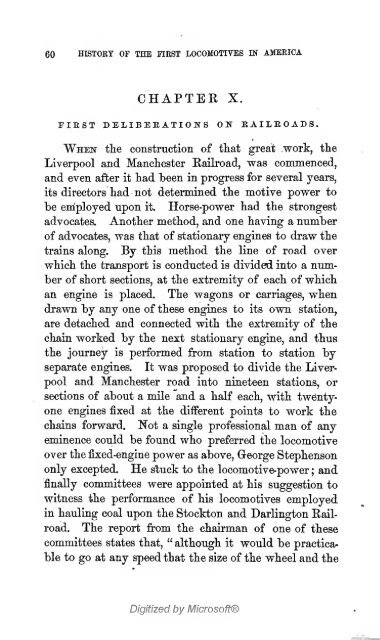The history of the first locomotives in America. From original ...
The history of the first locomotives in America. From original ...
The history of the first locomotives in America. From original ...
Create successful ePaper yourself
Turn your PDF publications into a flip-book with our unique Google optimized e-Paper software.
60<br />
HISTORY OF THE FIRST LOCOMOTIVES IN AMERICA<br />
CHAPTER X.<br />
FIKST DELIBEEATIONS CM" EAILEOADS.<br />
When <strong>the</strong> construction <strong>of</strong> that great work, <strong>the</strong><br />
Liverpool and Manchester Railroad, was commenced,<br />
and even after it had been <strong>in</strong> progress for several years,<br />
its directors had not determ<strong>in</strong>ed <strong>the</strong> motive power to<br />
be eniployed upon it. Horse-power had <strong>the</strong> strongest<br />
advocates. Ano<strong>the</strong>r method, and one hav<strong>in</strong>g a number<br />
<strong>of</strong> advocates, was that <strong>of</strong> stationary eng<strong>in</strong>es to draw <strong>the</strong><br />
tra<strong>in</strong>s along. By this method <strong>the</strong> l<strong>in</strong>e <strong>of</strong> road over<br />
which <strong>the</strong> transport is conducted is divided <strong>in</strong>to a number<br />
<strong>of</strong> short sections, at <strong>the</strong> extremity <strong>of</strong> each <strong>of</strong> which<br />
an eng<strong>in</strong>e is placed. <strong>The</strong> wagons or carriages, when<br />
drawn by any one <strong>of</strong> <strong>the</strong>se eng<strong>in</strong>es to its ovTn station,<br />
are detached and connected with <strong>the</strong> extremity <strong>of</strong> <strong>the</strong><br />
cha<strong>in</strong> worked by <strong>the</strong> next stationary engiue, and thus<br />
<strong>the</strong> journey is performed from station to station by<br />
separate eng<strong>in</strong>es. It was proposed to divide <strong>the</strong> Liver-<br />
pool and Manchester road <strong>in</strong>to n<strong>in</strong>eteen stations, or<br />
sections <strong>of</strong> about a mile and a half each, with twenty-<br />
one eng<strong>in</strong>es fixed at <strong>the</strong> different po<strong>in</strong>ts to work <strong>the</strong><br />
cha<strong>in</strong>s forward. Not a s<strong>in</strong>gle pr<strong>of</strong>essional man <strong>of</strong> any<br />
em<strong>in</strong>ence could be found who preferred <strong>the</strong> locomotive<br />
over <strong>the</strong> fixed-eng<strong>in</strong>e power as above, George Stephenson<br />
only excepted. He stuck to <strong>the</strong> locomotive-power ; and<br />
f<strong>in</strong>ally committees were appo<strong>in</strong>ted at his suggestion to<br />
witness <strong>the</strong> performance <strong>of</strong> his <strong>locomotives</strong> employed<br />
<strong>in</strong> haul<strong>in</strong>g coal upon <strong>the</strong> Stockton and Darl<strong>in</strong>gton Rail-<br />
road. <strong>The</strong> report from <strong>the</strong> chairman <strong>of</strong> one <strong>of</strong> <strong>the</strong>se<br />
committees states that, " although it would be practica-<br />
ble to go at any speed that <strong>the</strong> size <strong>of</strong> <strong>the</strong> wheel and <strong>the</strong><br />
Digitized by Micros<strong>of</strong>t®
















